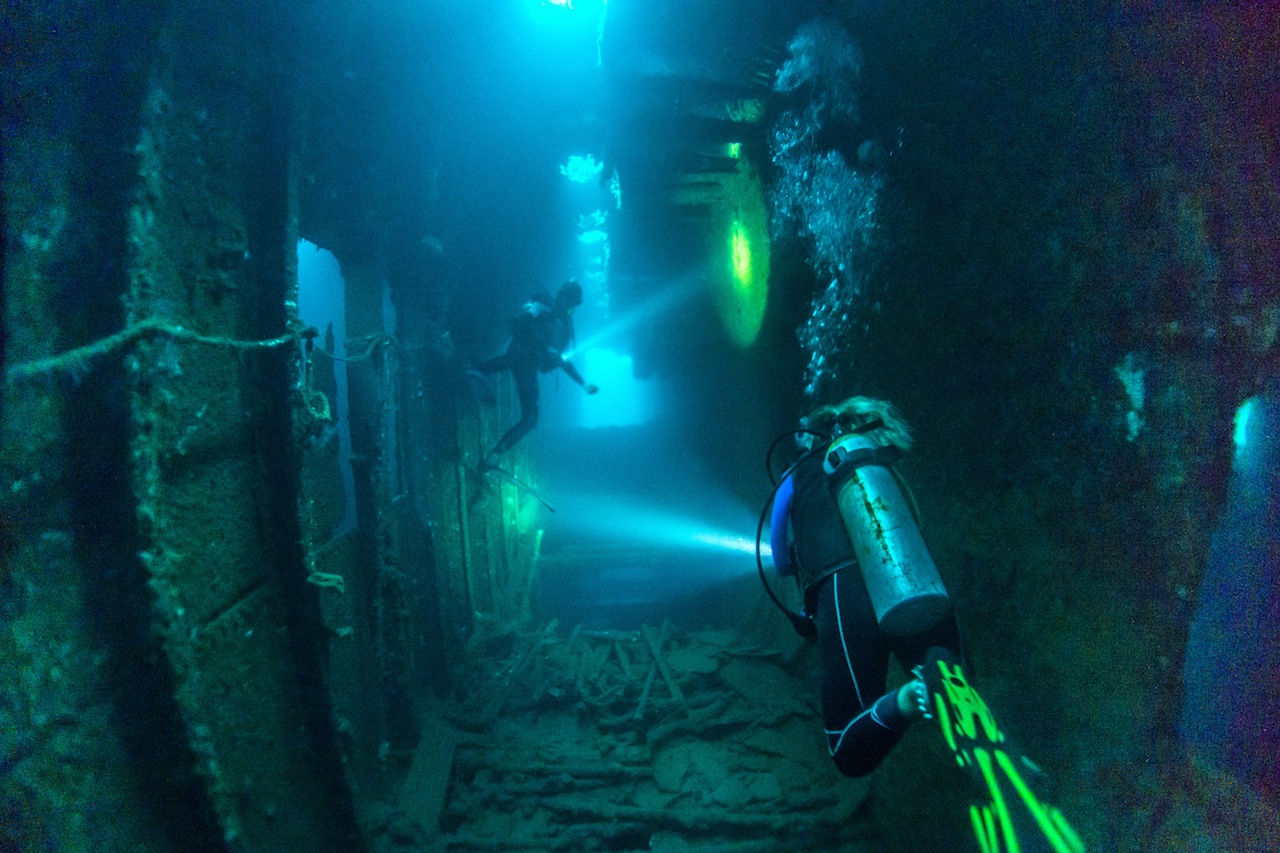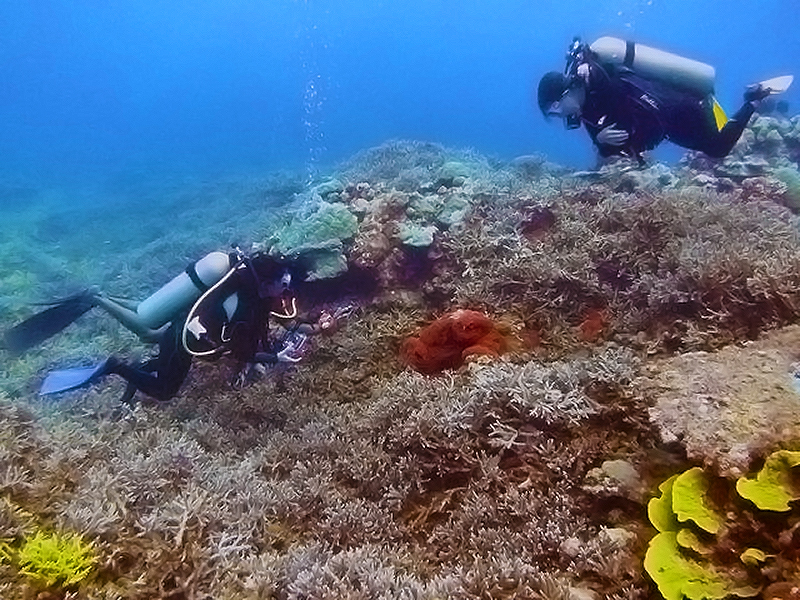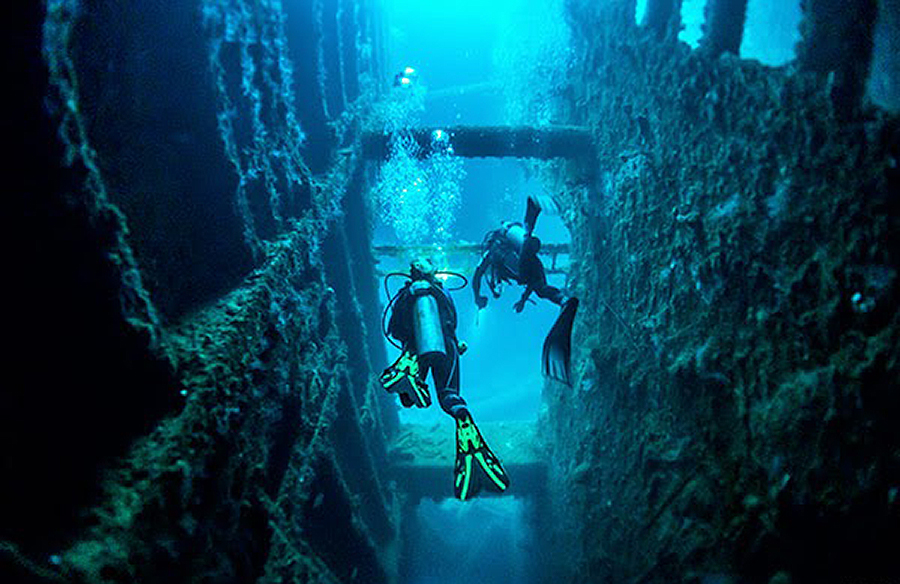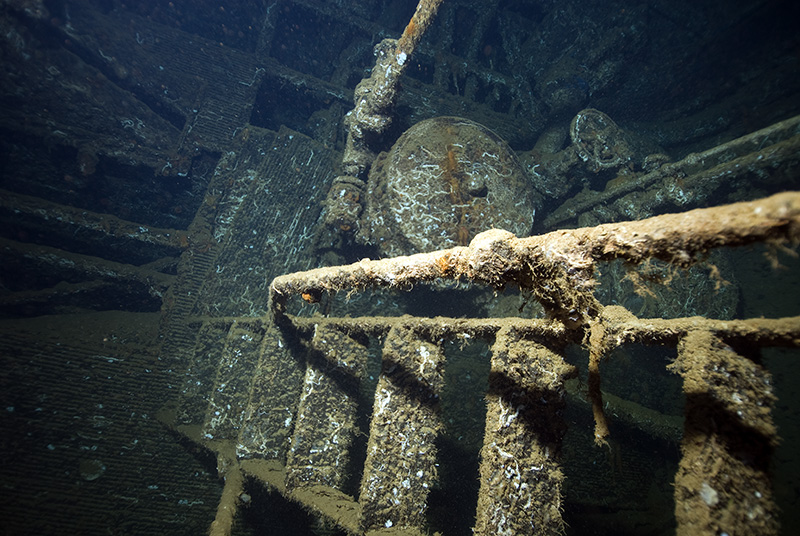Diving Vicariously: Following A Budding Diver in Vanuatu
An aspiring diver’s biggest question is often ‘Where can I get my PADI?’ Once that’s taken care of, the next question is ‘Where’s the best place to test my new-found skills?’ I answer both of these questions by following a budding diver on his journey to one of the best diving destinations in the world, all while only getting my toes wet, dangling my legs safely off the deck of a boat or skipping along the shoreline of one of the largest dive wrecks in the world, the SS President Coolidge.

Starting With The Basics: Theorising The Dive
Paul, our budding diver, and I are picked up from our resort by Mike Crawford, a fellow Kiwi and the owner of Big Blue Scuba Dive. The moment we exchange hellos, we know that we are in safe hands. The man is a legend around here and has been exploring, and helping others explore, the South Pacific Ocean for more than 25 years. A big part of selecting the right PADI dive centre comes down to the trustworthiness of the establishment and the experience of its staff.
The Big Blue headquarters is part of a line of concrete shacks with palm-thatched roofs that sit along the seawall in downtown Port Vila. Its waterfront, salt-in-the-air, sand-in-my-hair ambience ensures relaxation is at the centre of the whole ‘learning to dive’ experience. While Paul talks with Mike, I eye up the rastafarian-style Nambawan Cafe next door. Its relaxed island vibe, Bob Marley tunes and varieties of the local Tusker beer assure me that my hopes of drinking beer on the beach between lessons can be realised.
Gaining an Open Water Diver PADI license is broken into three parts: knowledge development (a full day of theory work and pre-testing); confined water dives (one day of gaining confidence in the water and testing the theory); and the open water dive (comprising four dives over two days). This is followed by a final exam that determines whether certification has been achieved or not.

Mike guides us to a little room at the back of the dive shop so that Paul can begin step one of his PADI Open Water Dive course. He sits in front of a computer and begins talking Paul through the online interactive theory course, which covers the underwater world, dive equipment, buddy systems, the dive environment, communication, dive planning, problem management, dive tables, dive computers and navigation. Divers usually have the choice of undertaking this course independently online or in a classroom environment.
Mike treats the entire lesson like a conversation, discussing scenarios and testing Paul as he moves across each subject, helping Paul’s mind absorb the information subconsciously. “It’s all just common sense, mate. You just have to learn to apply that common sense when you’re down there,” says Mike. We listen to horror stories about what can go wrong, which has Paul on the edge of his chair. It’s reassuring to know that Big Blue has never had any diving incidents.
A classroom session with a divemaster like this one can be a lot more beneficial and engaging than working through the theoretical modules independently. I have to admit I feel sleepy during some parts of the theory work and find myself looking forward to Paul’s controlled dives in the pool tomorrow.
In Control: Pool Learning
The sun shines gloriously, an infinity pool mimics the colour of the azure ocean it fronts, the fronds of palm trees dance gently on the beach and four budding divers with their grinning instructors line up equipment at the edge of the pool. It’s the first day of practical work here on the island and we are at Breakas resort, gearing up for our first underwater breathing session. It’s all a bit like a watching reality TV show for me, seeing these adventurers face their fears while I sip pina coladas on my lounger.
The session begins. Divers sit by their gear and listen as instructors explain what each component is, what it does, how it connects and how to use it. The divers then put all the gear together themselves and, after checking that everything is ready, put on their diving suits. From here, they jump into the pool and stand at the shallow end, submerging and taking a seat at the bottom of the pool in order to practise breathing. Once confident, divers move to the deep end of the pool where they go through the 24 skills they have been learning.

Jerry, Paul’s instructor, is a rather comical guy. He is chirpy, full of good humour and laughs a lot, making him easy to get along with and to learn from. He helps Paul work through the skills one-on-one, explaining how each one would be used in a particular diving scenario. He gives Paul an example: he shakes himself under the water, as if tangled, and then takes his diving gear off, whilst keeping the oxygen tank between his legs so it does not float away. He takes a big long breath through his mask, puts the mask down and pretends to untangle the gear. He puts the gear back on then points at Paul, signalling that it’s his turn.
There are many scenarios just like this one, some as simple as emptying a mask that’s full of water and others more advanced, like sharing a single tank if a diving buddy runs out of oxygen. One skill is fundamental: communication. Instead of coming up above the water to discuss their training, everything between Paul and Jerry is communicated underwater using hand gestures. This is essential practice ahead of the open water dive.
The Big Blue: Open Water Challenge
The big day has arrived for Paul to put his theory to the test in the wild and unpredictable open water, at a depth of 12 metres.
Jerry is overly cheery today, almost to the point where I believe it might be borderline insanity. Does he not realise that this is serious stuff? He’s continuously cracking jokes, laughing and having a grand time. The truth is, diving instructors often behave this way to put their students at ease, making for a calmer and safer dive. With 25,000 dives under Jerry’s weight belt, Paul can be assured that his instructor is in control and this confidence is transferred to him.
It takes 30 minutes to get to Kate’s Corner, our first dive spot. It’s a full boat and there are two big groups being dropped into the abyss. Happy, nervous, serious, blank; diverse expressions are on the faces of those sitting around the boat, waiting for instructions. Paul seems quite confident and eager to go. He does a quick safety check, gives himself some extra weight and is ready to go. Jerry instructs all divers to move to the back of the boat, jump in, swim around to the anchor line and wait there for him. One by one, in a single file, all divers jump in.
The water is clear and the divers can see the sea floor, helping ease fears about possible predators waiting underneath. An exploration of the reef reveals tropical fish, sea fans, sea cucumbers and an abundance of other marine life. The beautiful underwater world unfolds in utter silence and that silence becomes a noise in itself.

Our budding divers are thrilled when they come across a plane wreck on the seabed. They take turns to sit in the pilot’s seat and explore the wreckage. The entire setting was actually planted there by our very own Mike Crawford in the hopes of offering another scenic outlet for explorers. The escapade got Mike in a lot of trouble with the government but after much debate, they reached a resolution and the plane’s home was made permanent.
Back on the boat, Paul describes the feeling of mindful calmness that surrounded him. His worries melted away as he entered a state of bliss. Luckily, he was only enjoying the stress-free feeling that comes with the weightlessness of being underwater rather than narcosis: a common phenomenon that is the result of a rise in nitrogen levels. It can only affect a diver at 30 metres and is harmless while staying within recreational depths, getting dangerous only when diving beyond 40 metres.
Four days since the beginning of this adventure, the final part of getting a PADI certification is the written exam. It’s a long exam, one that requires Paul to concentrate for hours. During this time, I am obliged to concentrate on a few Tusker beers, a delicious beef burger, hot chips, a pizza and a couple of kava coladas. It’s the toughest exam I have ever sat.
“Hurry up,” I finally say. “Don’t you want to have some beer?” Jerry rocks up behind me and grabs a handful of chips. “Let him finish or he may not make it to his next dive,” he jokes.
Beauty In The Deep: Exploring The SS President Coolidge
Two 12-metre dives and two 18-metre dives later, it’s time for Paul to dive again, this time deeper. And what a sensational way to do it: diving to depths of 30 metres, floating through time on a shipwreck that once carried 100 critically injured naval troops from Hawaii during the 1941 attack on Pearl Harbour.
The SS President Coolidge is one of a kind and a rare opportunity for most divers. A former luxury liner, transformed into a US naval ship during the Second World War, it took two lives when it sank, alongside all its cargo, with relics dating back to the mid 1900s. In 2015, it was named one of the best three dives in the world by the PADI organisation itself and there’s little wonder why. It’s a shore dive that offers countless perspectives due to the sheer size and complexity of the ship, meaning, a diver could dive the ship 10 times from different locations and still only see a part of her.

Paul dives with Allan Power Dive Tours. They are the most experienced dive operators on the island of Espiritu Santo — the largest island in the nation of Vanuatu. Allan Power is known on the island as ‘Mr President’ as it was 40 years ago that he came to Santo on a salvage expedition, becoming the true ‘caretaker’ of this magnificent ship. Although Allan does not take others diving anymore, divers have the opportunity to sit with Allan for a cup of tea and cake and enjoy his vast historical knowledge: 15,000 dives worth of knowledge.
The divers make their way down the beach in the direction of the dive site. Paul is in the care of Tim, an experienced dive-master with an astounding knowledge of the ship. He’s a serious man, strict in his demeanour and very different in nature to Jerry.
As soon as Paul and Tim reach waist depth, they put on their flippers, push forward and submerge. The dive begins with great visibility, as clear as the waters in Port Vila, but the deeper they go, the murkier it gets. Within the cloudy water appears a wreckage, a sacrifice made to the water gods of Santo. Over the process of 74 years, the ship has transformed into an artificial reef and is home to a variety of marine life. It’s a success story for the ability of artificial reefs to attract marine life to a location.
The divers explore the front of the ship with the key highlights being cargo holds one and two. They come across what was once the barrel of a Long Tom cannon, a 155 millimetre Howitzer and other military gear including jeeps and a 10-wheel General Motors Corporation truck. Outside the cargo holds they find the cannons and ammunition bay. Paul pulls out and holds a 75 millimetre wide missile shell. He travels back in time, imagining what might have been in 1941.

The deeper Paul goes, the more air he begins consuming. He realises that the rate at which he is consuming it is much faster than his previous dives. Nerves set in and he signals Tim to communicate the situation. Tim’s expression is of concern and so they begin their ascent, monitoring the levels closely. At their safety stop, Tim hands Paul his regulator so that he can use it to prevent his tank from going into the red.
The pair pop above the surface with sufficient oxygen and the first open diver’s lesson is truly learnt: awareness is the key to a safe and enjoyable dive but it can sometimes be forgotten in the time capsule that is the underwater world. There’s much beauty in the inner depths of our planet, one that we can fully immerse ourselves in — we just have to remember to catch the ride home.
Learning To Dive: Takeaway Advice
If apprehensive about diving, the best thing to do is follow someone else on their journey; most dive schools and operators are happy taking a spectator alongside another diver.
Safety is paramount underwater and diving with a dive buddy is advised for both beginner and advanced divers. A dive buddy acts as an extra pair of eyes that helps avoid dangerous situations on underwater adventures. Ensuring that there are people on land that know about a diver’s location is also important, as this becomes crucial if something goes wrong.
A new diver who has just completed their training is only permitted to dive up to 18 metres alongside other scuba divers of the same level, only when support is available at the surface and under conditions that are equal or better than the conditions where they were trained. Going beyond this limit is only permitted when accompanied by a dive leader.
The diver in this story met the ISO 24801-2 Diver Level 2-Autonomous Diver Standard and dived to a depth of 30 metres because he felt comfortable with his abilities and was accompanied by a dive leader the entire time. The SS President Coolidge dive also offers an 18 metre dive option, where beginners can view the ship from a distance until they complete their Advanced Open Water Diver Course.
Vanuatu is a prime destination to learn to dive, gain further certification and then test skills in some of the most incredible settings in the world. Dive sites worth exploring in Vanuatu include: Million Dollar Point and Chails Reef in Espiritu Santo; Star of Russia and The Cathedral in Port Vila; and Katiua Rocks in Tanna.
Watch: Axel Warnstedt captures the spectacular underwater sites of the Pacific island of Vanuatu.
Fly Air Vanuatu from Australia, New Zealand, Fiji, New Caledonia, and the Solomon Islands.
